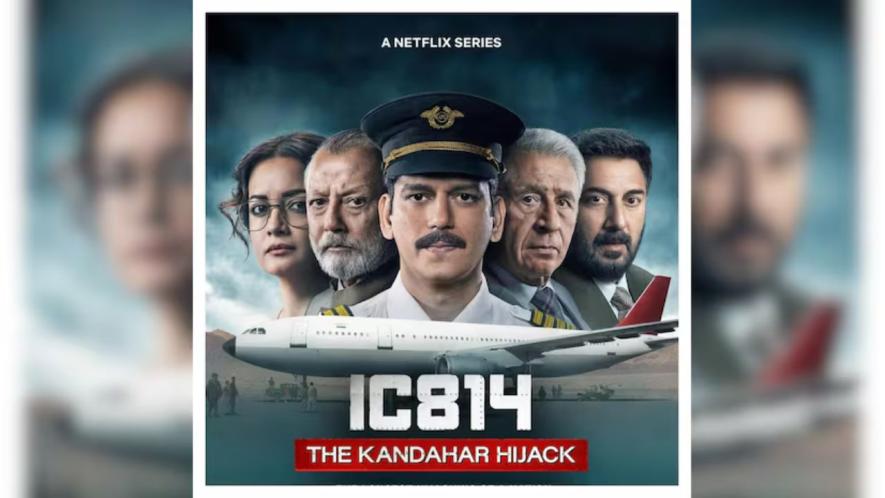The Mysterious Men Aboard Hijacked IC-814

Image Courtesy: Twitter
Quite a lot has been reported in the media recently about the hijack of Indian Airlines flight IC-814, 25 years ago. The spate of these reports and interviews of top officials who were part of the crisis management at that time, came in the wake some Right-wing outfits/individuals objecting to the so-called “Hindu” codenames given to the characters of the hijackers in the latest Netflix series titled IC-814 – The Kandahar Hijack.
Netflix officials were summoned by the government for clarification. This was despite the fact that official data itself showed that these codenames were the ones used by the five hijackers themselves to hide their real identities during the eight-day ordeal in December 1999. Netflix also agreed to put out the real names of the hijackers in the disclaimers accompanying the series.
In this longest-ever hijack episode in India, the Airbus A-300 widebody aircraft that took off from Kathmandu for Delhi was diverted over the Lucknow airspace to land in Amritsar for refueling. However, the hijackers got suspicious that the aircraft would be blocked from taking off. They then directed the pilots, led by Capt Devi Sharan, to take off without refueling, forcing them to fly even without any flight clearance by the Amritsar air traffic control.
The plane took off to land at the nearby Lahore airport in Pakistan for fuel. The Pakistan government first refused permission and then allowed the aircraft to land, refuel and take off, despite urgent calls from the Indian government as well as Indian High Commissioner G Parthasarathy to hold it for some more time. Thereafter, it flew to Dubai, where 27 passengers, mostly women, children and some aged, were let off. The hijackers also handed over the body of Rupin Katyal, who was stabbed to death inside the plane when he got into a fisticuff with them. Katyal and his wife were returning home after their honeymoon in Nepal. After Dubai, the aircraft landed at Taliban-controlled Kandahar, its last stop.
In the recent media reports, some names of important officials or relatives of some officials in the then Atal Bihari Vajpayee government, who were among the passengers, have been revealed. These included that of the then Kathmandu station head of the Research and Analysis Wing (R&AW), SBS Tomar, who was the First Secretary in the Indian High Commission in Kathmandu. Seated in seat 16C, Tomar was flying to Delhi to visit his hospitalised wife.
As per a book authored by former R&AW officer R K Yadav, it was alleged that Tomar had ignored and dismissed intelligence information from his junior about the possibility of a plane hijack by Pakistan-based terrorists from Kathmandu in the near future. Yadav alleged in his 2014 book, Mission R&AW, that he had also rebuked his junior, questioned the veracity of his intel inputs and “suppressed” the report without forwarding it to the headquarters. Tomar, according to Yadav, was later sent to the United States on a cushy foreign assignment “instead of punishment for negligence which resulted in such a big fiasco”.
During the eight-day crisis, the Indian officials did not disclose Tomar’s name due to the probable ramifications it could have had. But on December 27, 1999, when the aircraft had already landed at Kandahar, Pakistan’s foreign ministry spokesperson announced that an Indian R&AW agent was on board and later gave out his name. However, it is not clear whether this information had reached the hijackers, as Tomar was not picked out by them and was later released like all other passengers.
THE SECOND MYSTERY MAN
But Tomar was not the only “high value” passenger aboard the ill-fated flight. The most valuable passenger, flying with his companion in the business class, was a Swiss-Italian billionaire who owned a UK-headquartered Swiss company that controlled 90% of the world’s currency printing business, including that of the US and India.
Roberto Giori was returning from a holiday in Nepal along with his companion Christina Calabresi. After the hijackers took over the aircraft, they shifted all business class passengers to the economy section, ostensibly for easier control of the plane and managing the people on board. The names of Giori, the owner of ‘De La Rue Giori Company’, and Calabresi were on the passenger manifest of IC-814. While their real high-profile identities remained hidden from the hijackers, their presence in the ill-fated aircraft was understood to have played a very important role in the mounting of international pressure on India during the already intense negotiations between hijackers and the Indian government representatives.
A report in Time magazine over 24 years ago, said: “De La Rue Giori, which Giori inherited from his father, happens to control 90% of the world’s currency-printing business.” It also said: “After the plane landed in Kandahar, southern Afghanistan, where it would remain for seven days, Switzerland sent a special envoy to the airport to deal with the abduction of its currency king, his companion and two other Swiss nationals. It also put pressure on New Delhi to come to a solution that ensured their safe release.”
HIJACKERS’ DEMAND FOR CASH
The hijackers were demanding nothing short of the release of three terrorists -- Ahmed Omar Saeed Sheikh, Maulana Masood Azhar and Mushtaq Ahmed Zargar -- in return for the hostages. Another major demand was that the Indian government pay them $200 million in cash, which had been immediately rejected.
A top official, who was part of the Crisis Management Team that was planning, coordinating and negotiating with the hijackers through the Taliban officials present in Kandahar, said that the US Administration was also in “panic mode” regarding the presence of Giori among those abducted. The official, since retired and wanting to remain anonymous, had told the writer that the cash was arranged with the help of US agencies, such as the CIA and flown in to Delhi before the then External Affairs Minister Jaswant Singh and some officials left for Kandahar along with the three terrorists. The cash in dollars was arranged from abroad as such a huge amount was not available domestically at that point in time, he had said, adding that the government had initially rejected the demand for cash.
The Time magazine report also said: "At one point during the eight-day hijacking of Indian Airlines Flight 814, the abductors demanded $200 million from the Indian government. Little did they know that one of the hostages sitting in economy class could have effortlessly written them a check for that amount.”
Some reports have spoken of a black briefcase and two large red bags. The briefcase, as per these reports, allegedly contained cash for payment of fuel and other services rendered to the hijacked plane by the Kandahar airport authorities and was carried by the relief aircraft from Delhi. The red bags were left behind on the tarmac for the hijackers or Taliban to pick up. It is, however, not clear whether these contained the cash sought by the hijackers or anything else.
However, it is known and has been reported that Masood Azhar, after his release in Kandahar on December 31, 1999, and on reaching Pakistan, suddenly became very cash rich. And within a few months, in the very next year (2000), he floated the deadly terror outfit ‘Jaish-e-Mohammad’ with the help of ‘Lashkar-e-Taiba’ and the ISI.
Giori’s company, De La Rue, a global player that still dominates the global business of currency note printing and production of features, such as security thread and holograms used in banknotes, was also a major supplier of these materials to India. After its name came up in the Panama Papers in 2016, the CBI launched a probe into its role in India. But that is a separate story.
Giori currently owns the Lausanne-based ‘The Robert Giori Company Ltd’ which deals with sophisticated technology relating to currency or fiduciary notes, their electronic transfers, computer and electronic systems dealing with financial transactions and other connected issues.
The hostage crisis ended on December 31, 1999, when the passengers and crew were released after the Indian government handed over the prisoners – Masood Azhar, Omar Sayeed and Mushtaq Zargar -- to the Taliban.
The diplomatic intervention by the Swiss and the US governments has been kept under wraps, but it had definitely added a layer of urgency to the already intense negotiations at that time. The entire episode shows that some mysteries are meant to remain mysteries.
Amitabha Roychowdhury has extensively covered issues concerning internal security, defence and civil aviation for the Press Trust of India for over three decades. Views are personal.
Get the latest reports & analysis with people's perspective on Protests, movements & deep analytical videos, discussions of the current affairs in your Telegram app. Subscribe to NewsClick's Telegram channel & get Real-Time updates on stories, as they get published on our website.
























